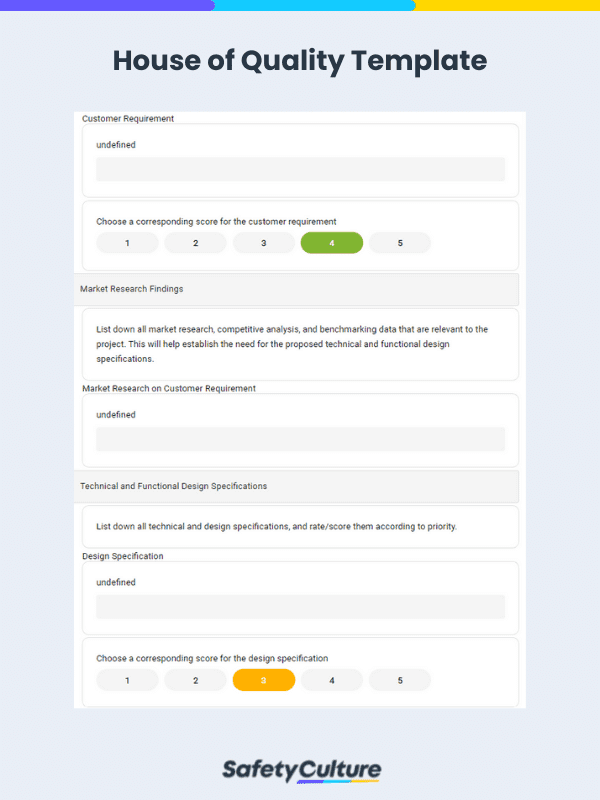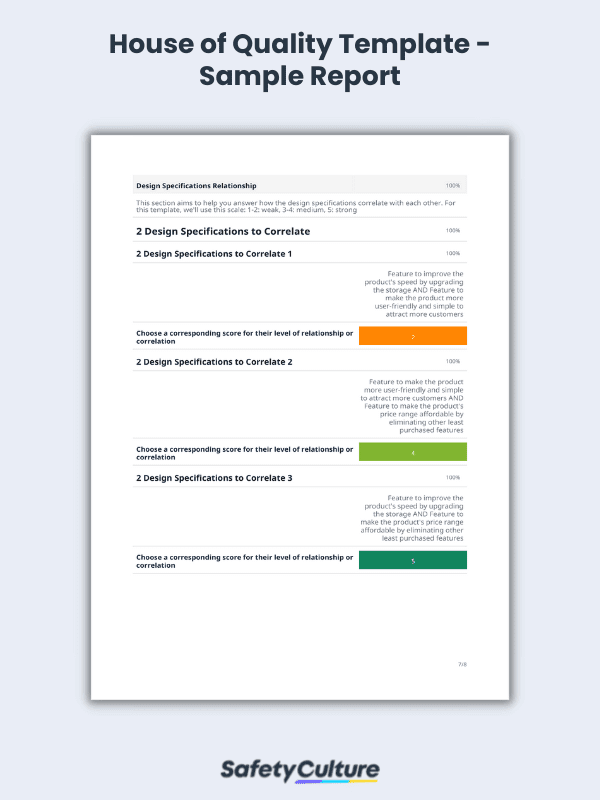What is a House of Quality Template?
A House of Quality (HoQ) template is used to help teams conduct effective Product Planning and Design stages in the overall process of Quality Function Deployment (QFD). The template consists of six main sections or components that list and outline customer requirements, design and engineering requirements, relationship matrices, and target values to determine which product specifications to prioritize in implementation. Hence, the HoQ diagram is built from the competitive and technical data gathered during the Voice of the Customer (VOC) analysis and market research.
Benefits of Using a House of Quality Template
The QFD process involves four stages: Product Planning, Product Development, Process Planning, and Production Planning. Each phase entails a variety of elements, steps, requirements, and activities to establish the right foundation for implementation. Hence, it’s needless to say that it’s a comprehensive methodology, and not to mention it’s aligned with an organization’s quality management system.
Likewise, QFD’s most essential stage, House of Quality, is one of the most technical stages in the process. With the six main sections that the HoQ consists of, it’s not impossible to overlook some details and implement actions that aren’t aligned with what was agreed upon. These may then affect the whole QFD process.
Using a template when creating a House of Quality helps you avoid such challenges and achieve optimal results in the first stage of the QFD through the following benefits:
- An established process of identifying customer needs, e.g. gathering the Voice of the Customer using VoC templates
- Scoring system for requirement prioritization
- Optimized way of determining design requirements
- Reliable method of defining the relationship between what the customer needs and how to achieve them through functional design specifications
- Standardized procedure of disseminating best practices in conducting a competitive analysis
What Does a House of Quality Template Include?
An HoQ template must cover the diagram’s main components and include a title page that lets you state basic details about the project (e.g. name, point person, and date) and a completion section (which allows you to include a sign-off portion). This is so everything is well-accounted for and can be used as a reference guide by other teams or departments for the succeeding stages of the QFD once the Product Planning stage is complete.
What are the Six Sections of a Basic House of Quality Matrix?
1. Rated Customer Requirements
This is where you list down all customer requirements that you need to address. Make sure to use a scoring system to easily see which ones you should consider prioritizing. Then, add any supplementary information necessary to establish the importance of each requirement.
2. Market Research Findings
Use this section to verify how each customer need is being addressed by other businesses or companies in the market. Benchmark such data to back up your plans, proposals, and priorities during the Product Planning and Design stage.
3. Technical and Functional Design Specifications
List all corresponding design specifics in relation to the customer needs. Again, use a scoring system to determine the ones you must prioritize.
4. Customer Requirements and Design Specifications Relationship
To help you relate one customer requirement to a design specification, use this section in your House of Quality template to score their level of correlation. This will help you put more context into how each customer need can be addressed once the product feature is implemented.
5. Design Specifications Relationship
Establish a unique scoring system to denote the relationships between all the design specifications you’ll list. This way, you’re able to put emphasis on cohesive features rather than randomly proposing product design specifications that seem too out of place.
6. Target Values in Design
The target design values are essential in evaluating the features or characteristics of the overall product design. In the template, you can use this section to record the objective, quantifiable measures that your team has agreed upon.
House of Quality Template Example
To help you better understand and visualize what a House of Quality matrix template looks like, here’s an example when you use it in SafetyCulture:




